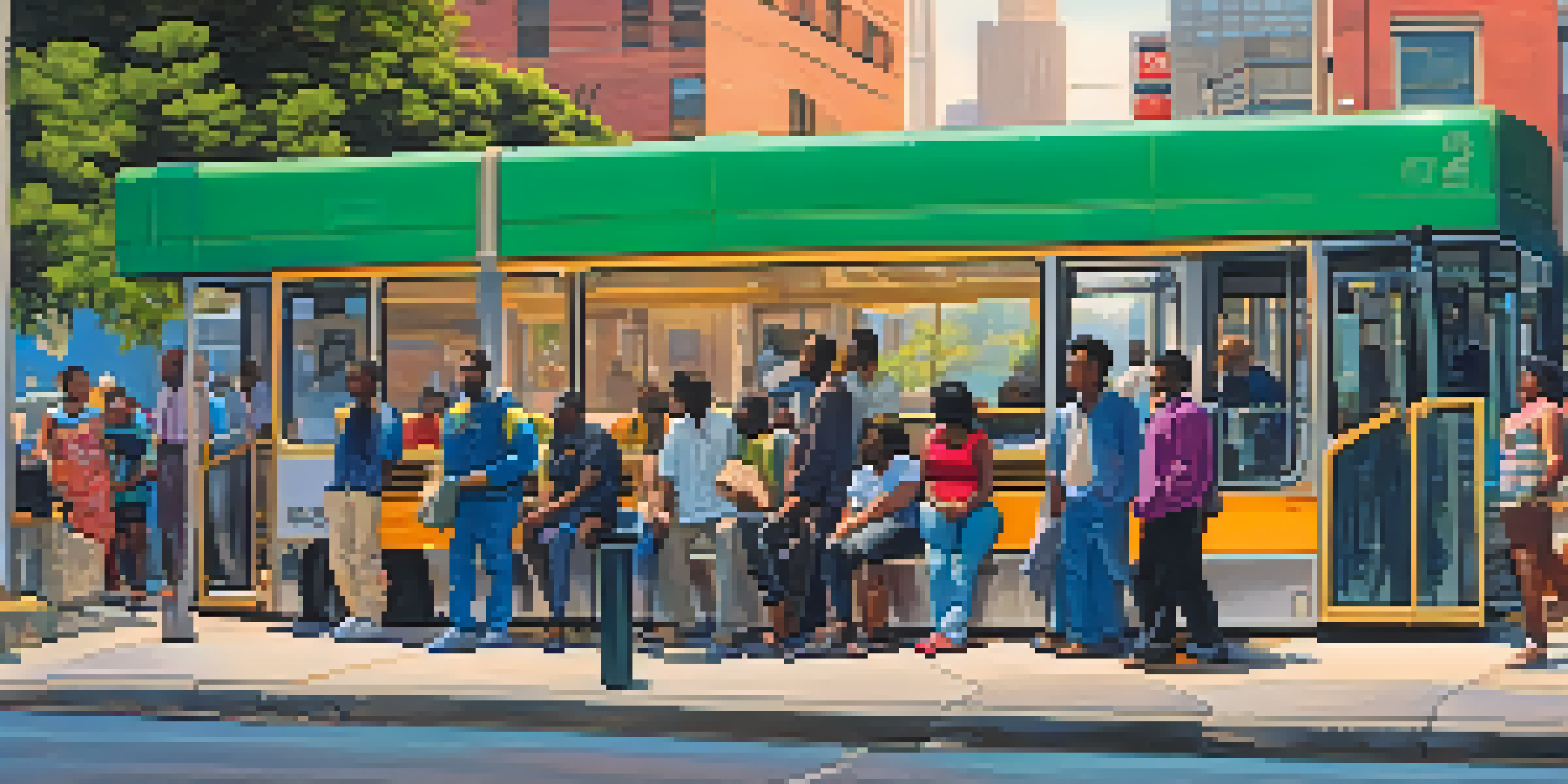Understanding Transportation Equity in Georgia: A Deep Dive

Defining Transportation Equity and Its Importance
Transportation equity refers to the fair distribution of transportation resources and services across all communities. This concept ensures that everyone, regardless of their economic status, race, or location, has access to reliable and affordable transportation options. In Georgia, where diverse populations coexist, understanding how transportation equity impacts daily life is crucial for fostering inclusivity.
Transportation equity is not just a policy goal; it's a moral imperative that ensures everyone can access the opportunities they need to thrive.
Imagine a family living in a rural area of Georgia without access to public transit. Their ability to find jobs, access healthcare, or participate in community events is severely limited. Conversely, urban residents may face different challenges, such as overcrowded buses or long commute times. Transportation equity seeks to address these disparities, making it a vital topic for policymakers and citizens alike.
Promoting transportation equity not only enhances individual mobility but also strengthens communities as a whole. When everyone has access to necessary resources, we see improved economic opportunities and quality of life. Thus, acknowledging and addressing transportation equity issues is essential for creating a more equitable society in Georgia.
Historical Context of Transportation in Georgia
To fully grasp transportation equity in Georgia, we must look back at the historical context. The state's transportation system has evolved significantly over the decades, often mirroring broader social and political changes. Historically, many communities, particularly those of color, faced systemic barriers that limited their access to transportation resources.

For instance, during the mid-20th century, urban renewal projects often displaced minority communities, disrupting their access to public transit. This legacy has left lasting impacts on how transportation services are allocated today. Understanding this history helps illuminate the ongoing challenges that many Georgians face regarding transportation equity.
Transportation Equity Defined
Transportation equity ensures all communities in Georgia have fair access to reliable and affordable transportation options.
Moreover, as Georgia continues to grow and diversify, the need to address these historical inequities becomes increasingly urgent. By acknowledging this past, we can better work toward solutions that ensure equitable transportation options for all residents moving forward.
Current Transportation Challenges in Georgia
Despite advancements, many Georgians still encounter significant transportation challenges. Areas with limited public transit often rely heavily on personal vehicles, which can be a financial burden for low-income families. Additionally, even in urban settings, inadequate infrastructure can lead to safety concerns for pedestrians and cyclists.
A community's strength lies in its ability to provide equitable access to resources, including transportation, for all its members.
For example, in cities like Atlanta, traffic congestion and a lack of reliable transit options can hinder people's ability to commute effectively. This situation disproportionately affects marginalized communities, who may not have the same access to alternative transportation methods. Addressing these challenges is crucial for promoting overall equity.
Furthermore, rural areas in Georgia often lack basic transportation services, making it difficult for residents to reach essential services. The disparity in access to transportation options illustrates the need for comprehensive planning that prioritizes equity and addresses both urban and rural needs.
The Role of Policy in Transportation Equity
Policy plays a pivotal role in shaping transportation equity in Georgia. Local and state governments have the power to implement measures that either enhance or hinder equitable access to transportation. By prioritizing policies that address inequities, lawmakers can create systems that benefit all residents, irrespective of their background.
One example of effective policy is the investment in public transit systems that serve underserved areas. Policies that promote multi-modal transit options, such as bus rapid transit or bike-sharing programs, can provide more equitable transportation solutions. By ensuring that policy decisions reflect the needs of diverse communities, Georgia can move towards a more equitable transportation landscape.
Historical Impact on Access
Georgia's transportation history reveals systemic barriers that have disproportionately affected marginalized communities.
Moreover, community engagement is essential in the policy-making process. By involving residents in discussions about transportation planning, decision-makers can better understand the unique challenges faced by different communities. This collaborative approach can lead to more effective and equitable outcomes.
Community Initiatives Promoting Transportation Equity
Across Georgia, various community initiatives are working tirelessly to promote transportation equity. Nonprofit organizations and grassroots movements are stepping in to fill gaps in transportation services, often focusing on marginalized communities. These initiatives highlight the power of community-driven solutions in addressing transportation challenges.
For instance, some organizations provide subsidized transportation options for low-income individuals, ensuring they can access employment and healthcare. Others advocate for policy changes that prioritize equitable transportation funding and infrastructure development. These efforts showcase the importance of local action in driving change.
Additionally, community engagement events, such as town hall meetings and workshops, allow residents to voice their concerns and contribute to transportation planning. By fostering collaboration between communities and local governments, these initiatives are paving the way for a more equitable transportation future in Georgia.
The Impact of Technology on Transportation Equity
Technology is transforming the landscape of transportation, offering both opportunities and challenges for equity in Georgia. Ride-sharing services, mobile apps, and real-time transit information have the potential to enhance accessibility and convenience. However, not everyone has equal access to these technological advancements, which can perpetuate existing disparities.
For example, individuals without smartphones or reliable internet may struggle to access ride-sharing services. Additionally, while technology can improve efficiency, it can also lead to increased costs that may not be affordable for low-income residents. Understanding the digital divide is essential to ensure that technological innovations benefit all Georgians.
Community Initiatives Drive Change
Local organizations are actively promoting transportation equity by addressing gaps in services and advocating for policy reforms.
Moreover, as cities explore smart transportation solutions, equitable access must remain a priority. Implementing technology in ways that enhance transportation equity—such as providing free Wi-Fi at transit stops or investing in accessible transit apps—can help bridge the gap. By being mindful of technological disparities, Georgia can create a more inclusive transportation system.
Future Directions for Transportation Equity in Georgia
Looking ahead, the future of transportation equity in Georgia will depend on sustained commitment from all stakeholders. Policymakers, community organizations, and residents must work collaboratively to address existing inequities and innovate new solutions. This collective effort is vital for building a transportation system that serves everyone effectively.
Investing in infrastructure improvements, expanding public transit options, and enhancing service accessibility will be key priorities. Additionally, ongoing assessment of transportation policies and community needs can help identify areas for improvement. By taking proactive steps, Georgia can lead the way in creating a more equitable transportation landscape.

Ultimately, achieving transportation equity is not just about improving access—it's about fostering a sense of belonging for all community members. When everyone can navigate their surroundings easily and safely, we not only enhance individual well-being but also strengthen the fabric of our communities. The journey towards transportation equity in Georgia is ongoing, but with continued dedication, it is a journey worth taking.